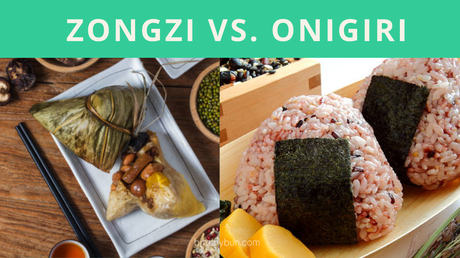Learning the names of different food dishes can be tricky, and especially if you are new to Asian cuisine.
Two dishes that are often mistaken for one another are zongzi and onigiri; they are both filled rice balls, but are they the same? What differentiates the two?
If you have ever had either of the two, it is not too hard to see where the confusion may come from, but they are actually two different things.

Both zongzi and onigiri are rice balls, but zongzi are Chinese rice balls while onigiri is Japanese. The ingredients and filling are also different, and a zongzi rice ball won’t taste the same as an onigiri rice ball even to an inexperienced palate.
The two also look different, as zongzi rice balls tend to be wrapped in Indocalamus tessellatus (bamboo leaves). Onigiri, on the other hand, is often wrapped in seaweed (nori).
Comparing onigiri vs. zongzi
It is a very common mistake to confuse onigiri and zongzi, and many people incorrectly believe them to be the same. Let’s dive into each of these dishes to learn more.
What is zongzi?
Zongzi is a type of rice ball from China, and they are also known as zong, rice dumplings, or sticky rice dumplings.
There are additional names for the same dish spread across the world, and if you are from Texas or California, you may even know these rice balls as Chinese tamales.
Steaming or boiling are the typical methods used to cook this popular dish, and it consists of rice (glutinous) filled with different things and wrapped up in a bamboo leaf, banana leaf, lotus leaf, or other large and flat leaves, or you may come across zongzi wrapped in reed.
The shape also varies depending on where you are and who made the zongzi, and the recipes are usually passed down in the family, as well as the wrapping technique.
When making zongzi, whole families tend to get together to help each other out. It is a very traditional dish that comes in many shapes and forms.
Zongzi fillings
If you are unfamiliar with zongzi, you may be surprised by how many options there are when it comes to fillings!
You can fill one with almost anything, but chicken, mung beans, vegetables, mushrooms, red meat, ham, eggs, and dried scallops are common.
You can also find traditional zongzi filled with lotus seed, cooked peanuts, and other nuts, Chinese sausage, yam, and jujube, and it is a truly versatile dish you won’t get tired of.
And onigiri? What is it?
It is not unusual for people to confuse onigiri with sushi, most likely due to its appearance, but it is actually not a dish that is considered a type of sushi!
Instead, it is a small rice ball that is either cylindrical or triangular in shape and wrapped at the base with seaweed.
Onigiri rice is usually plain but may have a bit of salt added, which sets it apart from sushi rice which usually contains a mix of salt, vinegar, and even sugar.
How the dishes were originally used and invented also differ significantly.
Onigiri comes from Japan, and not from China like zongzi, and tends to be made with boiled (white) rice. On some occasions, you may also find onigiri made with fried rice, maze-gohan, or glutinous rice.
Onigiri fillings
Both zongzi and onigiri are rice balls with different fillings, but the typical fillings differ somewhat.
Onigiri can be filled with pickled fruit or vegetables, dried fish and other dried foods, shrimp or tuna with mayonnaise, squid, nori, shuto, mentaiko (processed roe), and more. You can even make sweet onigiri if you like!
You may also come across plain onigiri – a rice ball without filling, but these are known as shio-musubi rather than onigiri, even though it is technically the same.
Other types of rice balls
When you have limited knowledge of Asian cuisine, it is no wonder you might end up confusing zongzi and onigiri, as they are both rice balls.
However, did you know that there are other types of rice balls as well, just to make it more confusing? Have you ever tried nigiri for example?
Learning to distinguish the different dishes is highly beneficial if you are interested in Asian cuisine, as it gives you the opportunity to try things you may have never tried before.
Conclusion
The conclusion here is that zongzi and onigiri are not the same. Both are rice balls, yes, and both come from Asia, but one is Chinese and the other is a Japanese dish.
The flavors are also quite distinct as they are often made with different types of rice and fillings.
Neither should be considered as sushi, as sushi has a different purpose and is made with a different process, but both are worth trying out if you haven’t already!
The next time you see zongzi or onigiri on the menu – ask what fillings they have available and get ready to enjoy a delicious dish!
Read next: Gyoza vs. dumpling | Gyoza is a dumpling, but not all dumplings are gyoza!
